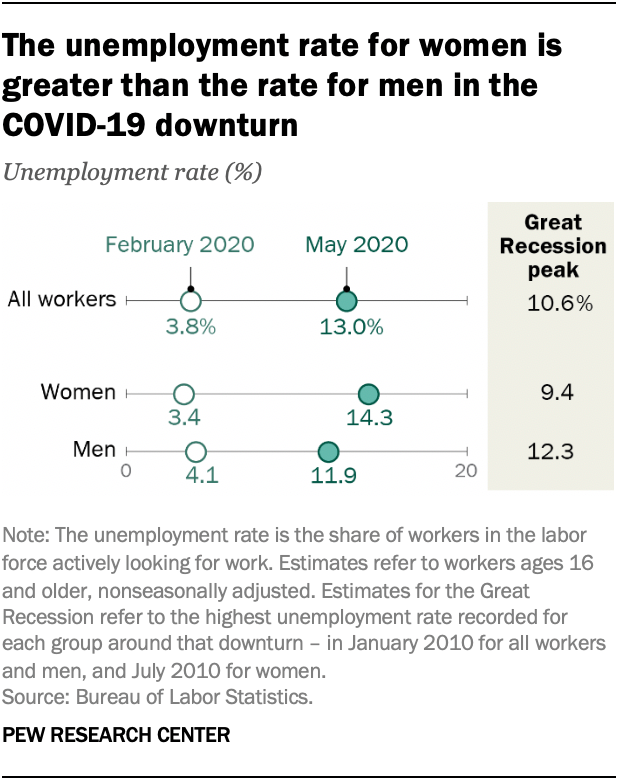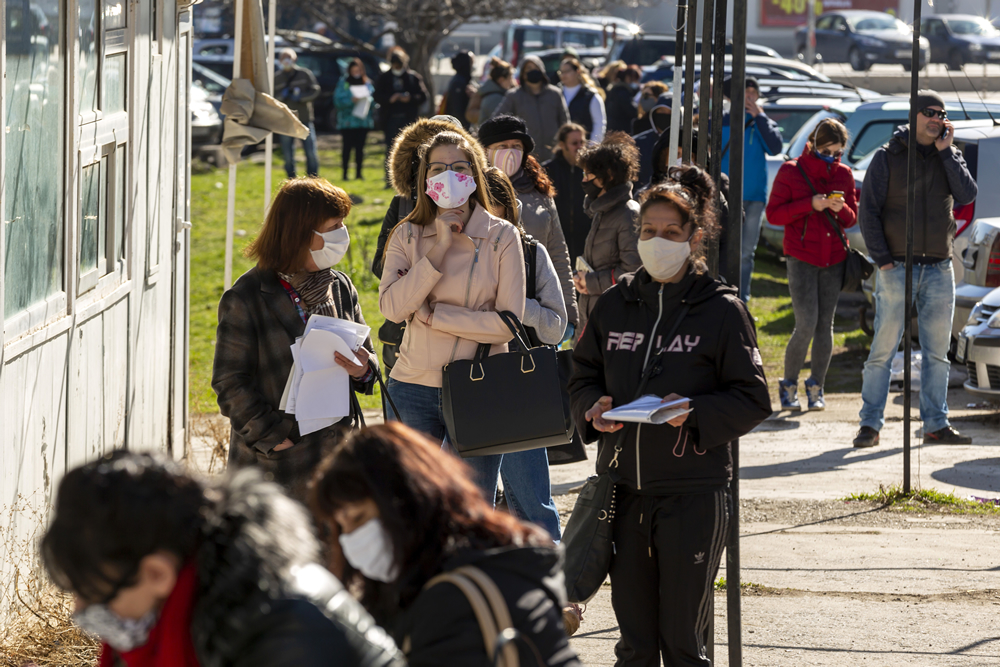More Women Leave Workforce Than Men
It would appear the COVID-19 pandemic is wreaking more havoc on women than men when it comes to their jobs, businesses, and finances.
According to several recent surveys, more women have left the workplace in comparison to men since the pandemic began. What’s more, women-owned businesses report significantly greater revenue loss brought on by state mandated lockdowns as compared to male business owners; and more female-owned businesses have permanently closed versus men who have shuttered their businesses.  “Women are bearing the brunt of COVID-19’s economic impact and that is bound to have ripple effects for years to come,” wrote Ann Senne, the head RBC Wealth Management – U.S. Advice & Solutions Group in Minneapolis, Minnesota, in an October 30, 2020 column for MarketWatch.com. “At the depths of the crisis in April, nearly 12 million women had lost their jobs compared with 10 million men.”
“Women are bearing the brunt of COVID-19’s economic impact and that is bound to have ripple effects for years to come,” wrote Ann Senne, the head RBC Wealth Management – U.S. Advice & Solutions Group in Minneapolis, Minnesota, in an October 30, 2020 column for MarketWatch.com. “At the depths of the crisis in April, nearly 12 million women had lost their jobs compared with 10 million men.”
Senne notes that from May to August, 7.5 million women returned to work. But then along came the 2020-21 school year in September when according to Smithsonian Magazine, 865,000 women voluntarily left the workforce to provide childcare and monitor at-home schooling for their children.
The end of summer saw fewer daycare facilities re-opening, many school districts did not re-open classrooms, and parents with safety concerns raised by COVID-19 opted to keep their kids enrolled in remote learning within some school districts that offered a hybrid program.
Again, the need presented for childcare and at-home schooling fell more squarely on the shoulders of women. In September, those 865,00 women were part of 1.1 million that were classified as “no longer working or looking for work” according to the National Women’s Law Center. Thus, 80 percent of those leaving the workforce to accommodate the needs of children were women.
It is another history-making record for women, but not one sought after considering that 2020 marked the 100th anniversary of women’s suffrage and the years of gains in women’s employment wiped out by the impacts of the COVID-19 pandemic.
According to experts in the field of women’s employment, a past model that could potentially guide where women in business go from here does not exist. “There is no historical example we can look back to in order to provide insight into the record number of women leaving, being pushed out of, or pulled away from the paid workforce because of the impact of COVID-19,” wrote Crystal M. Moten, a curator and historian in the division of work and industry at the Smithsonian’s National Museum of American History, in an October 2020 article in the museum’s online magazine.
“There is no historical example we can look back to in order to provide insight into the record number of women leaving, being pushed out of, or pulled away from the paid workforce because of the impact of COVID-19,” wrote Crystal M. Moten, a curator and historian in the division of work and industry at the Smithsonian’s National Museum of American History, in an October 2020 article in the museum’s online magazine.
Whilst the American economy struggles to overcome COVID-19 and we really have precious little to chart the future with, there are a few measurements by which we can note what has been lost.
• Of the 865,000 women leaving the workforce in September, 324,000 were Latina and 58,000 were black, according to the NWLC.
• Since February 2020, the job losses incurred to women represented 53.9 percent of the overall net job loss to the American economy, also according to the NWLC.
• At the start of the pandemic, there were 5.4 million businesses owned by women in the United States, according to the National Bureau of Economic Research. By September, that number dropped to 4 million.
But there may be hope that 2020’s lemons will become 2021’s lemonade.
A survey in late October by JustBusiness reports that one in five of this fall’s new entrepreneurial endeavors were not on their creators’ agenda until the economic reality of COVID-19 took hold. A third indicated that changes in the marketplace prompted them to look at starting a new business.  The U.S. Census Bureau – highly active in 2020 taking the decennial count of the American population – documents a 93 percent increase in new business applications as opposed to 2019 according to what those filling out the census forms are telling census workers via the Business Formation Statistics Report.
The U.S. Census Bureau – highly active in 2020 taking the decennial count of the American population – documents a 93 percent increase in new business applications as opposed to 2019 according to what those filling out the census forms are telling census workers via the Business Formation Statistics Report.
Those numbers weren’t broken down by gender, but it wouldn’t surprise Andrew Levy, president of RockRidge Financial Services, LLC, based in Norcross, Georgia, just outside of Atlanta.
“Absolutely,” he said when asked if he thought the pandemic might result in attracting more women to become entrepreneurs. “I know that COVID-19 has resulted in many women to become entrepreneurs.”
Since late spring 2020 when “stay-at-home orders” locked down much of the country, Levy said his firm has seen an increase in women asking for advice on how to start their own business. He estimates that 30 percent of his firm’s new clients in 2020 are women seeking financial guidance as they take their first big steps in starting their own business.  Darcy O’Brien, chief marketing officer with Simon Quick Advisors based in Morristown, New Jersey, looks for some of those entrepreneurial women to join the financial services industry.
Darcy O’Brien, chief marketing officer with Simon Quick Advisors based in Morristown, New Jersey, looks for some of those entrepreneurial women to join the financial services industry.
“I hope so,” she said when asked if she thought the pandemic might result in attracting more women to the financial advisor profession. “The pandemic has forced the business community to re-evaluate their work from home policies. The flexibility to work from home is an important benefit for many women in their childrearing years.”
O’Brien detailed Simon Quick’s commitment to a flexible and supportive working environment for female advisors and employees. She said it is viewed “as crucial towards retaining our female talent so they will choose to grow their careers” with the firm.
Leanin.org echoes that sentiment with an entire section of its website dedicated to how women can better balance career and kids. The site offers a variety of “chat circles” women can join to yes, commiserate and share their challenges, but more importantly, to connect with other women and potentially learn new coping skills.
Beyond connection with other women, Levy sees other needs for women using COVID-19 as a launching platform for a new business.
“Many of the women coming to us seek strategic financial guidance and counsel as they take their first big steps in starting their own business,” he said. “While many have needed help in proper corporate setup, the overwhelming majority recognize the important of having a qualified team to surround them. This enables them to focus on their core competencies and where they will create the greatest value for their business.”
Levy and O’Brien’s optimistic thinking is a glimmer of hope among dark clouds for women in business in 2020. They aren’t the only people hoping women can find a way back to a profitable bottom line.
Women’s magazines are abuzz with encouraging headlines on how getting through 2020’s experience with COVID-19 is creating new opportunities for entrepreneurs with two X chromosomes.
It just could be the year that the multi-tasking skill of monitoring the kiddos school progress while keeping them from engaging in food fights in the at-home school cafeteria – aka the dining room – combined with somehow still meeting those work-oriented deadlines becomes resume worthy material.
Even the U.S. Chamber of Commerce – a business promoting organization that traditionally has not approached business from a gender position – has stated that women have been “disproportionately” impacted by COVID-19. From surveys charting how women feel about the prospects of their business to providing advice and direction on business topics specific to women, the national chamber is leading the charge in helping women win the economic battle created by COVID-19. “We cannot allow this pandemic to set back a generation of entrepreneurial women,” said Suzanne Clark, president of the U.S. Chamber of Commerce, in a recent article addressing the question of “why COVID is hurting more women owned businesses” on the chamber’s website. “We need to help struggling small business safely reopen and stay open so they can continue to grow and create jobs in their local communities. The health and existence of small business is essential to the economic recovery of our nation.”
“We cannot allow this pandemic to set back a generation of entrepreneurial women,” said Suzanne Clark, president of the U.S. Chamber of Commerce, in a recent article addressing the question of “why COVID is hurting more women owned businesses” on the chamber’s website. “We need to help struggling small business safely reopen and stay open so they can continue to grow and create jobs in their local communities. The health and existence of small business is essential to the economic recovery of our nation.”


